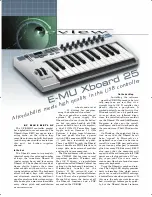
10-234
KDFX Reference
KDFX Algorithm Specifications
966 Stereo Image
Stereo enhancement with stereo channel correlation metering
PAUs:
1
Stereo Image is a stereo enhancement algorithm with metering for stereo channel correlation. The stereo
enhancement performs simple manipulations of the sum and difference of the left and right input
channels to allow widening of the stereo
fi
eld and increased sound
fi
eld envelopment. After manipulating
sum and difference signals, the signals are recombined (a sum and difference of the sum and difference) to
produce
fi
nal left and right output.
Figure 10-123 Block diagram of Stereo Image algorithm
The sum of left and right channels represents the mono or center mix of your stereo signal. The difference
of left and right channels contains the part of the signal that contains stereo spatial information. The Stereo
Image algorithm has controls to change the relative amounts of sum (or center) versus difference signals.
By increasing the difference signal, you can broaden the stereo image. Be warned, though, that too much
difference signal will make your stereo image sound “phasey”. With phasey stereo, acoustic images
become dif
fi
cult to localize and can sound like they are coming from all around or from within your head.
A bass shelf
fi
lter on the difference signal is also provided. By boosting only the low frequencies of the
difference signal, you can greatly improve your sense of stereo envelopment without destroying your
stereo sound
fi
eld. Envelopment is the feeling of being surrounded by your acoustic environment.
Localized stereo images still come from between your stereo loudspeakers, but there is an increased sense
of being wrapped in the sound
fi
eld.
The Stereo Image algorithm contains a stereo correlation meter. The stereo correlation meter tells you how
alike or how different your output stereo channels are from each other. When the meter is at 100%
correlation, then your signal is essentially mono. At 0% correlation, your left and right channels are the
same, but polarity inverted (there is only difference signal). The correlation meter can give you an
indication of how well a recording will mix to mono. The meter follows RMS signal levels (root-mean-
square) and the RMS Settle parameter controls how responsive the meter is to changing signals. The ‘M’
part of RMS is “mean” or average of the squared signal. Since a mean over all time is neither practical or
useful, we must calculate the mean over shorter periods of time. If the time is too short we are simply
following the signal wave form, which is not helpful either, since the meter would constantly bounce
around. The RMS Settle parameter provides a range of useful time scales.
See also the Stereo Analyze algorithm which allows you to experiment directly with sum and difference
signals.
L Output
R Output
L Input
R Input
Center Gain * 1/2
Diff Gain * 1/2
-
-
Содержание K2661
Страница 18: ...2 4 LFOs LFO Shapes...
Страница 34: ...3 16 DSP Algorithms...
Страница 54: ...5 4 MIDI Note Numbers Note Numbers for Percussion Keymaps...
Страница 72: ...7 10 System Exclusive Protocol K2661 System Exclusive Implementation...
Страница 82: ...9 4 Upgrading Sample Memory Choosing and Installing a SIMM for K2661 Sample Memory...
Страница 334: ...10 252 KDFX Reference KDFX Algorithm Specifications...
Страница 340: ...11 6 Glossary...
Страница 382: ...12 42 Triple Modular Processing Alphanumeric Buttonpad Entries for DSP Functions...
Страница 392: ...B 6 SysEx Control of KDFX MSB and LSB...
Страница 442: ...D 20 Contemporary ROM Block Objects Controller Assignments Contemporary ROM Block...
Страница 490: ...H 12 General MIDI Standard Mode Controller Assignments...
Страница 492: ...I 2 Live Mode Objects Live Mode Programs...
Страница 498: ...K2661 Musician s Reference Index...
Страница 500: ......
















































